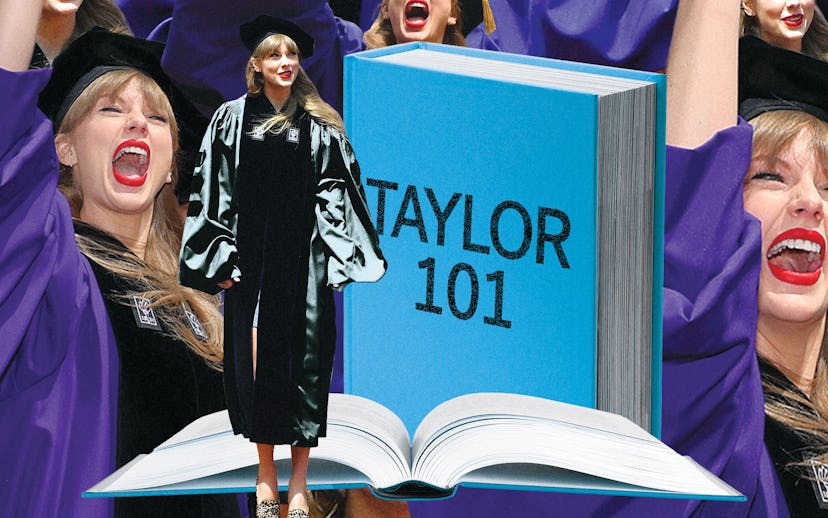
Entertainment
What I Learned At Taylor Swift University
At Berklee College of Music, a new class exploring the discography of Taylor Swift doesn’t just teach lessons in songwriting.
It’s 3 p.m., and I’m locked in a staring contest with a jumble of black dots and lines. They scatter across a projection screen in front of me like a poem in a foreign language. Technically, the markings are music notes from Taylor Swift’s song “I Knew You Were Trouble,” but professor Scarlet Keys — who’s leading a class of roughly a dozen students through a songwriting exercise — calls them Swift’s ticket to global success. “It's simple melodies that pay for swimming pools,” she says.
It’s week three of Boston’s Berklee College of Music’s “The Music of Taylor Swift,” a new course that chronologically dissects the lyricism and musicianship of one album per class. Last Thursday, we counted the syllables of Fearless; this week we’re studying Speak Now’s love stories (plus this brief detour into Red). It’s part of a wave of new Taylor Swift-centric syllabi that has been cropping up at prestigious universities like Harvard and Stanford that only seems to be growing: The class I’m sitting in now debuted last fall with one just section, but has attracted so much student interest it’ll have three next semester.
We begin each class with an exercise akin to dissecting a Shakespeare play: poring over lyric sheets peppered with bolded and underlined words to consider. Today’s first analysis is of “Speak Now,” which pops with annotations for strong verbs, pronoun repetition, and Swift’s poetic term for a pricey wedding: “white veil occasion.” We read — then sing — the lines aloud, sounding out satisfying plosives, alliterations, and hooky rhythms. The point, Professor Keys says, is to comb Swift’s catalog for songwriting techniques students may have unknowingly glossed over.
She reveals the significance of seemingly ordinary word choices, like Swift’s use of the imperative “drop everything now” on “Sparks Fly,” which commands attention and creates palpable energy. Questions, like the yearning lyric “you wish it was me, don’t you?” tucked into “Speak Now,” do the same. Together, we trip over pronouncing “polyptoton,” a term for the literary strategy of bunching together different words derived from the same root, à la “careless man’s careful daughter” on “Mine.” Even Swift’s punchy use of the word “yeah” serves some bigger purpose. I’d always thought of the term as lyrical filler, but Professor Keys explains that interjections create and heighten emotion: A well-placed “yeah,” she says, offers listeners an accessible outlet for their enthusiasm, distress, or angst. I’m suddenly stunned by my own snobbery: “Yeah” is probably one of the most unifying chants in existence.
I’m not the only one having an epiphany. Shea Dewan, a second-year songwriting major who claims to have been a Swiftie since age 4, says she’s also seeing her discography in a new light. “The coolest thing for me that I’m really taking away from this is to not shy away from simplicity,” she says. “At Berklee, you [can] get lost trying to make everything complex and special, but simplicity really does work.” Meanwhile, Emma Engle, a third-year student also majoring in songwriting, says she’ll probably listen to “Speak Now” on the walk home to pick out every technique from that day’s class. Though her mother was originally skeptical about the course, Engle says she’s stocking up on songwriting strategies to use in her own art.
“I realize that it’s far more engaging to emulate a musician you know and respect than a more “serious” one with whom you have no connection.”
In the following weeks, she and her classmates will use melismas, interjections, and other methods to craft original songs for graded assignments; otherwise, there’s no homework (though, like Engle, students do after-class deep dives into Swift’s catalog on their own). The course will culminate in a collaborative songwriting project that will test their hand at Swiftian style: to create a rhythm you could “hand to a stadium,” as professor Keys puts it, and know they’d follow along with ease.
Keys says her own motivation behind pitching this course stemmed from witnessing her young daughter using “Mean” to process a rift with a friend. “She is building a massive fan base and connecting with her audience — and really having an effect on young people and people of all ages that need a name for their feelings,” Keys says. “I thought, 'Why aren’t we studying all these techniques with an artist the students are in love with?’ What a way to learn!’”
Nowhere is the latter half of that observation clearer than when I mingle with the class. Students often chime in with their personal observations and ties to Swift, and compose tales of sunsets over boardwalks and grass-stained summer clothes. As I witness them blend stories from their own lives with the tenets of her songwriting, I realize that it’s far more engaging to emulate a musician you know and respect than a more “serious” one with whom you have no connection. And though only time will tell if someone sitting at a nearby desk will one day be selling out arenas like Taylor Swift, I’ve learned exactly what can happen when you have a story to share with the world.